
Installation
1716
Water Supply Requirements
Gather the required tools and parts before
starting installation. Read and follow the
instructions provided with any tools listed here.
TOOLS NEEDED:
• Flat-blade screwdriver
• 7/16" and 1/2" Open-end or two adjustable
wrenches
• 1/4" Nut driver
• 1/4" Drill bit
• Cordless drill
IMPORTANT:
• All installations must meet local plumbing code
requirements.
• DO NOT use a piercing-type or 3/16" (4.76
mm) saddle valve which reduces water flow and
clogs more easily.
• Use copper tubing and check for leaks. Install
copper tubing only in areas where the household
temperatures will remain above freezing.
Connect the Water Supply
IMPORTANT: If you turn the refrigerator on
before the water line is connected, turn the ice
maker OFF.
Connect to Water Line
1. Unplug refrigerator or disconnect power.
2. Turn OFF main water supply. Turn ON nearest
faucet long enough to clear line of water.
3. Locate a 1/2" to 1-1/4" (12.7 mm to 31.8 mm)
vertical cold water pipe near the refrigerator.
IMPORTANT:
• Make sure it is a cold water pipe.
• Horizontal pipe will work, but drill on the top
side of the pipe, not the bottom. This will
help keep water away from the drill and
normal sediment from collecting in the valve.
4. Determine the length of copper tubing you
need. Measure from the connection on the rear
of the refrigerator to the water pipe. Add 7 ft
(2.1 m) to allow for cleaning. Use 1/4"
(6.35 mm) O.D. (outside diameter) copper
tubing. Be sure both ends of copper tubing are
cut square.
5. Using a cordless drill, drill a 1/4" hole in the
cold water pipe you have selected.
A.Cold water pipe
B.Pipe clamp
C.Copper tubing
D.Compression nut
E.Compression sleeve
F. Shutoff valve
G.Packing nut
F
G
A
B
C
D
E
Installation
Connect to Water Line (cont.)
6. Fasten the shutoff valve to the cold water pipe
with the pipe clamp. Be sure the outlet end is
solidly in the 1/4" drilled hole in the water pipe
and that the washer is under the pipe clamp.
Tighten the packing nut. Tighten the pipe
clamp screws slowly and evenly so washer
makes a watertight seal. DO NOT overtighten
or you may crush the copper tubing.
7. Slip the compression sleeve and compression
nut on the copper tubing as shown. Insert the
end of the tubing into the outlet end squarely
as far as it will go. Screw compression nut onto
outlet end with adjustable wrench. DO NOT
overtighten.
8. Place the free end of the tubing in a container
or sink, and turn ON the main water supply.
Flush the tubing until water is clear. Turn OFF
the shutoff valve on the water pipe.
Connect to Refrigerator
1. Create a service loop (minimum diameter of 2
ft. [61.0 cm]) with the copper tubing. Avoid
kinks when coiling the copper tubing.
2. Remove the plastic cap from water valve inlet
port. Place a compression nut and sleeve on
the copper tubing.
3. Insert the end of the copper tubing into the
water valve inlet port. Shape tubing slightly so
that the tubing feeds straight into the port to
avoid kinks.
4. Slide the compression nut over the sleeve and
screw into the water valve inlet port.
5. Using an adjustable wrench, hold the nut on
the plastic water line to keep it from moving.
Then, with a second wrench, turn the
compression nut on the copper tubing
counterclockwise to completely tighten.
DO NOT overtighten.
6. Check connection by pulling on copper tubing.
Attach copper tubing to refrigerator cabinet
with a “P” clamp. Turn on water supply to
refrigerator and check for leaks. Correct any
leaks.
A.Plastic water tubing
B.Sleeve
C.Compression nut
D.Copper tubing
B
A
C
D
A.“P” clamp
B.Plastic water line
C.Compression nut
D.Copper tubing
C
B
D
E
A














